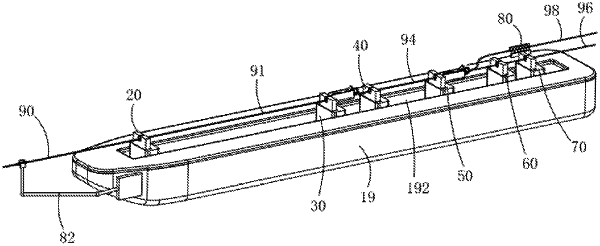| CPC A61B 34/37 (2016.02) [B25J 3/00 (2013.01); A61B 2034/301 (2016.02); A61M 25/0113 (2013.01)] | 17 Claims |

|
1. A slave-end apparatus for an interventional robot, comprising: a body, and a first drive mechanism, a second drive mechanism, a third drive mechanism and a front clamper distal to the first drive mechanism that are successively mounted on the body; wherein the front clamper is positioned at a front side of the body and configured to be retractable between an extended position where the front clamper moves to an outside of the body along an extending direction of the body and a hidden position where the front clamper moves back onto the body relative to the front of the body,
the first drive mechanism is configured to clamp and rotate a first catheter and a second catheter, the second drive mechanism is configured to clamp and rotate the second catheter and a third catheter, and the third drive mechanism is configured to clamp and rotate a first guide wire and a second guide wire; and
in a case that the first guide wire runs into the second catheter, the second catheter runs into the first catheter, and the first guide wire, the second catheter and the first catheter are respectively clamped by the third drive mechanism, the second drive mechanism and the first drive mechanism and move along a same axial direction on the body toward the front clamper to a desired position, the first catheter, the second catheter and the first guide wire are respectively taken off from the first drive mechanism, the second drive mechanism and the third drive mechanism, the front clamper and the first drive mechanism take over to clamp the first catheter and the second catheter, the third catheter is caused to run into the second catheter and the second guide wire is caused to run into the third catheter, and the third catheter and the second guide wire are respectively clamped by the second drive mechanism and the third drive mechanism and move along the same axial direction on the body toward the front clamper;
wherein the first drive mechanism and the second drive mechanism are configured to collaboratively clamp the first guide catheter to drive the first guide catheter to move forward, when the first drive mechanism moves to an extreme position and is to be restored to release the first guide catheter, the second drive mechanism is configured to clamp the first guide catheter to prevent movement thereof; when the first drive mechanism is restored to a proximal position between the front clamper and the second drive mechanism, the first drive mechanism is configured to clamp the first guide catheter again, and the first drive mechanism and the second drive mechanism are configured to collaboratively drive the first guide catheter to move forward again, in such way that operations are repeated until the first guide catheter moves to a desired position;
wherein the front clamper is configured to be connected with an Y adapter connected to the first catheter and to rotate a Luer connector of the Y adapter to drive the first catheter to rotate.
|